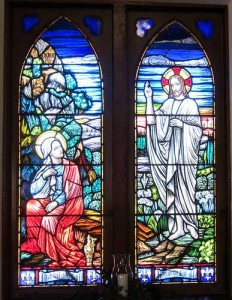 As I cross the Potomac River on my Sunday morning drive to St. Hugh’s, I’m typically treated to a beautiful scene filled with peaceful water, impressive monuments, a rising sun, and a sky colored with brilliant shades of red, orange, and blue. As I take in this sight, I often imagine that another Sunday, the first Easter morning, must have been beautiful as well. I think of Mary Magdalene making her way to the tomb, and I picture her as disheveled, head hung low in grief, and bleary-eyed from weeping and a lack of sleep. But then I try to imagine the change that must have come over her when she finally realized that her beloved Jesus had risen from the dead. I wonder what she did. Did she shed tears of joy? Did she leap or dance or burst into song? Did she fall on her knees, lift her head, and raise her hands to the sky in a gesture of gratitude to God?
As I cross the Potomac River on my Sunday morning drive to St. Hugh’s, I’m typically treated to a beautiful scene filled with peaceful water, impressive monuments, a rising sun, and a sky colored with brilliant shades of red, orange, and blue. As I take in this sight, I often imagine that another Sunday, the first Easter morning, must have been beautiful as well. I think of Mary Magdalene making her way to the tomb, and I picture her as disheveled, head hung low in grief, and bleary-eyed from weeping and a lack of sleep. But then I try to imagine the change that must have come over her when she finally realized that her beloved Jesus had risen from the dead. I wonder what she did. Did she shed tears of joy? Did she leap or dance or burst into song? Did she fall on her knees, lift her head, and raise her hands to the sky in a gesture of gratitude to God?
The Bible doesn’t tell us, so I guess that this side of heaven we’ll never really know what Mary Magdalene did. But I think it fair to say that she didn’t just stand there, and that her joy over Jesus’ resurrection was expressed with more than just words. Perhaps, for those first moments, she couldn’t find anything to say at all. Which would be understandable, because the Resurrection is such a marvelous and magnificent event that it’s hard to find the right words to describe it. Mere words can’t seem to do it justice.
In a sense, we Christians on Easter morning are a bit like the victorious team at the Super Bowl. As they celebrate their victory, the winning players express their jubilation by jumping, shouting, hugging, running, dog piling, pumping their fists, slapping high fives, lifting teammates on their shoulders, popping champagne bottles in the locker room, and dumping Gatorade on  their coach. It would seem that they have to express their joy with much more than words.
their coach. It would seem that they have to express their joy with much more than words.
The same is true for us today. We celebrate the rising of Jesus from the dead! The Son of God, who died for us on a cross, has risen to new life so that we might live in hope of living forever with him in heaven. This is something far more wonderful than winning a Super Bowl ring. In fact, it’s far more wonderful than anything else we will ever have, learn about, or experience. So how can words alone possibly be sufficient to celebrate such an event? We sing, “This is the day the Lord has made! Let us rejoice and be glad!” But that’s not enough. There has to be something we can do, in addition to what we can say. Not necessarily jumping or dancing, although maybe we can imagine doing that. And while I can sprinkle Holy Water on all of you, please do not dump any Gatorade on me.
Perhaps the greatest thing we can do to celebrate the resurrection with more than words it to share some of the love that Jesus has already shared with us by rising from the dead. Consider the two disciples in today’s gospel. We know that Peter was one of them. The other is simply identified as the “beloved disciple.” He’s not given a name here; we’re just told that Jesus loved him. But, in a sense, that’s all we need to know. Because even though he was a real person, the so-called “beloved disciple” represents each one of us because we, like him, are beloved of Jesus.
Remember what the beloved disciple did. When he and Peter learned from Mary Magdalene that Jesus’ tomb was empty, they ran to the tomb. Which is a reasonable thing to do, given the circumstances. Yet the gospel makes the point that they actually got into something of a race, and the beloved disciple won. Then he waited at the tomb, so that Peter could go in first. But what’s the point of our knowing this? Who cares which disciple was the fastest? Who cares that Peter went into the tomb first? Is this just a bit of biblical trivia, or is there some hidden meaning here?
Indeed there is a hidden meaning here. We’re meant to understand that the beloved disciple ran so fast, not because he was especially quick or Peter was particularly slow, but because he was impelled forward by his great love for Jesus. Yet he chose to allow Peter to enter the tomb first, not because he was courteous or catching his breath or afraid of going in, but because he acknowledged the authority of Peter, the head of the band of disciples and, of course, our first pope. By acting in this way, the beloved disciple shows the rest of us who are loved by Jesus how we can celebrate his resurrection with more than words. Like him, our lives are to be driven by love for Jesus within the fellowship of, and under the authority of, the Church and its chief shepherd, the pope.
shepherd, the pope.
At the beginning of this Mass, we were sprinkled with Holy Water, the water of baptism, to remind us of our own baptism and the promises that we made, or were made for us, on that day. Immediately after this homily, we will renew those baptismal promises, and pledge once again to live a life driven by the love of Jesus, and lived within the Church. We will promise to reject sin, so we can live in real freedom. We will promise to reject the “glamour of evil”- in other words, all the selfish, materialistic, and superficial temptations of our culture. We will promise to reject Satan, who hates us as much as Jesus loves us. And we will renew our promise, and I quote, “to serve God faithfully in his holy Catholic Church.” Should we honor these promises, we will be able to celebrate the resurrection of Jesus with far more than mere words.
Readings for today’s Mass: http://www.usccb.org/nab/042411.shtml
Photo Credits (top to bottom): randomduck, avinashkunnath, http://www.flickr.com/photos/jbtaylor/, via Creative Commons
